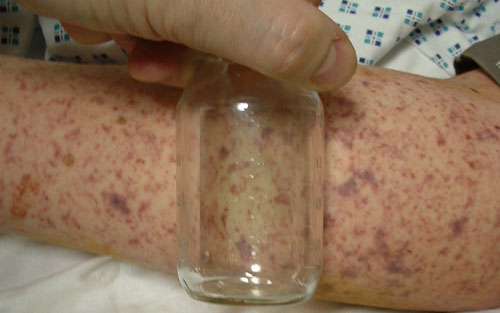








|
CASE HISTORY
Case History
12 year old boy referred to hospital by his GP. He was found to be febrile & drowsy with a few non-blanching spots. The GP gave a dose of intra-muscular penicillin and sent him into hospital as an emergency.
18:00 hours ED triage
Fever for a day, generally unwell with headache, regular paracetamol during day. No urine output since very early morning. No neck stiffness or vomiting. Temperature not coming down, new rash on back, increasingly drowsy.
Observations: temp 39.5, pulse 148, RR40, Cold hands and feet. Sats 92% in air.
Conscious level is V (AVPU scale). Widespread non- blanching rash on trunk
Nursing actions: probable meningococcal disease, put out emergency call for paediatrics. High-flow oxygen started via facemask. BM done = 6.5.
|
QUESTIONS ON CASE 8

 Q 1 of 10: Adequate assessment?
Q 1 of 10: Adequate assessment?
YesNo 
INCORRECT
: Good relevant history given the GP's actions - v low urine output recorded. Good observations - comprehensive enough to show what was wrong with this child. There were signs of circulatory insufficiency, so BP should have been taken, but nurse correctly put out a crash call and ensured that BP was measured within 15 minutes.
|
Further Information
Initial assessment of any febrile child
For all febrile children the following should be undertaken:
The following clinical signs must be measured and recorded to complete a full assessment:

Full-blown non-blanching haemorrhagic rash*
| Age
| HR/min
| RR/min
| Systolic BP
|
| <1 |
110-160 |
30-40 |
70-90 |
| 1-2 |
100-150 |
25-35 |
80-95 |
| 2-5 |
95-140 |
25-30 |
80-100 |
| 5-12 |
80-120 |
20-25 |
90-110 |
| Over 12 |
60-100 |
15-20 |
100-120 |
From Advanced Paediatric Life Support—the Practical Approach. 30
|
|
LOOK IT UP

|



















































